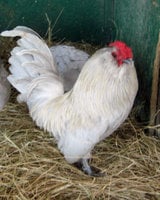The d'Anver is one of the oldest know breeds of true bantam in the world.
Yet They are not very common out side the base color of quail. Personally I set out to change that and now have them bred up to 30 colors and working on more.
They are just the perfect little bantams. Males can be aggressive, but it's usually only in defense of his territory and his hens, which is a great trait to have in a bird. Last thing you want is a male who will bail on his broody mate.
They are very proud looking birds. The males carriage should be erect, chest out, tail up, and head sharp.
They are a rose combed breed, so they so very well in cold climates. Comb should be close fitting to the skull, broad in front tapering to a nice point in the back. It should follow the curvature of the skull, and be well spiked and void of any dips or hollow spots.
The beard and muffs should be thick and full and show no wattle, basically a set of eyes, and a beak should be all you can see threw the beard.
Legs are slate except in colors that dont allow for it like cuckoo, those will always be a mottled pearl leg color, there's nothing we can do about that, it's genetics.
There are no special housing or dietary needs. They take both heat and cold very well. They lay very well, though some of the rarer colors are slow. Production can start at 6 months, but is usually the following spring after they hatch. Hens will go broody and be very protective, but you have to allow them to. If you take eggs daily, they will just continue to lay.
Size wise, they should be about 26 ounces on the male and 22 on the hens, very small.
Hens are the most gentle of all chickens out there, most can be held with ease. Males come in 2 versions, grumpy and grumpier, with an occasional lap dog. Due to their tiny size though, their aggression is more of an aggravation than harm to most.
All in all, for a bantam, they are just perfect!
Yet They are not very common out side the base color of quail. Personally I set out to change that and now have them bred up to 30 colors and working on more.
They are just the perfect little bantams. Males can be aggressive, but it's usually only in defense of his territory and his hens, which is a great trait to have in a bird. Last thing you want is a male who will bail on his broody mate.
They are very proud looking birds. The males carriage should be erect, chest out, tail up, and head sharp.
They are a rose combed breed, so they so very well in cold climates. Comb should be close fitting to the skull, broad in front tapering to a nice point in the back. It should follow the curvature of the skull, and be well spiked and void of any dips or hollow spots.
The beard and muffs should be thick and full and show no wattle, basically a set of eyes, and a beak should be all you can see threw the beard.
Legs are slate except in colors that dont allow for it like cuckoo, those will always be a mottled pearl leg color, there's nothing we can do about that, it's genetics.
There are no special housing or dietary needs. They take both heat and cold very well. They lay very well, though some of the rarer colors are slow. Production can start at 6 months, but is usually the following spring after they hatch. Hens will go broody and be very protective, but you have to allow them to. If you take eggs daily, they will just continue to lay.
Size wise, they should be about 26 ounces on the male and 22 on the hens, very small.
Hens are the most gentle of all chickens out there, most can be held with ease. Males come in 2 versions, grumpy and grumpier, with an occasional lap dog. Due to their tiny size though, their aggression is more of an aggravation than harm to most.
All in all, for a bantam, they are just perfect!


